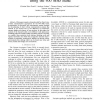13 search results - page 1 / 3 » Channel Model for Train to Train Communication Using the 400... |
VTC
2008
IEEE
13 years 11 months ago
2008
IEEE
Abstract—This paper presents a channel model for direct trainto-train communication appropriate for the 400 MHz band. Extrapolation of theoretical and experimental results obtain...
TIT
2010
12 years 11 months ago
2010
We consider the capacity of a wideband fading channel with partial feedback, subject to an average power constraint. A doubly block Rayleigh fading model is assumed with finite co...
ICC
2007
IEEE
13 years 8 months ago
2007
IEEE
Abstract-- Channel estimation for frequency-selective timevarying channels is considered using superimposed training. We employ a discrete prolate spheroidal basis expansion model ...
ICC
2007
IEEE
13 years 11 months ago
2007
IEEE
— We consider the optimal amount of training for single-antenna Rayleigh flat fading channels with peak-powerlimited input. The receiver uses known training symbols to perform m...
ICASSP
2009
IEEE
13 years 11 months ago
2009
IEEE
In this paper we consider the problem of sampling far below the Nyquist rate signals that are sparse linear superpositions of shifts of a known, potentially wide-band, pulse. This...

